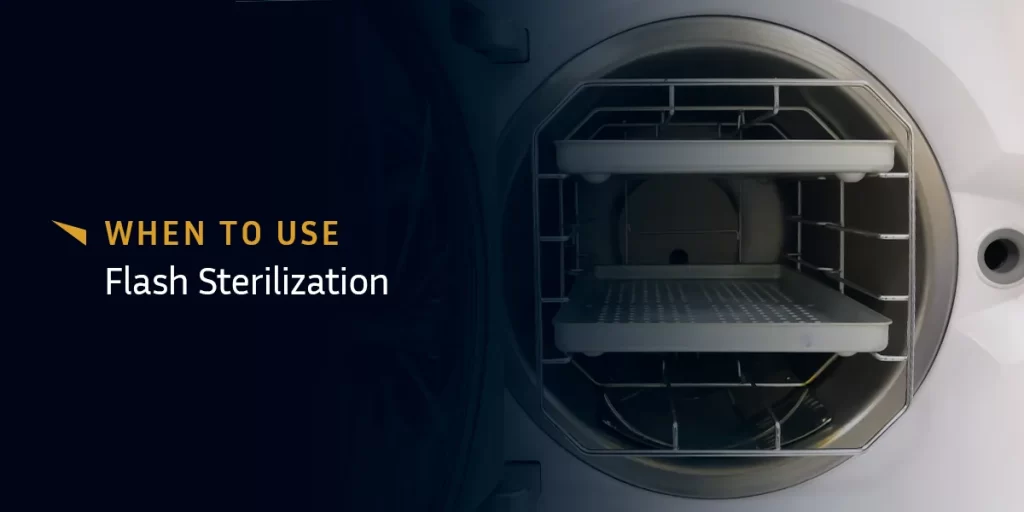
Decades ago, scientists and industry experts referred to flash sterilization as a process when unwrapped medical instruments required abbreviated sterilization cycles if used immediately without needing storage. This process differed significantly from the lengthier methods that involved sterilizing devices within wrappers, cases or primary packaging designed to maintain sterility and storing the instruments for specific periods. The term flash arose from the abbreviated time of steam exposure.
Today, industry regulators use the term immediate-use sterilization to more accurately describe the process. Medical facilities utilize this technique when processing items not intended for storage or when technicians require specific instruments immediately for an emergency procedure.
What Is Flash Sterilization?
According to the Centers for Disease Control and Prevention (CDC), flash sterilization involves placing an instrument in an open tray or container with rapidly penetrating steam while using cycle times much shorter than traditional sterilization methods. While conventional gravity or vacuum methods occur at 250 degrees Fahrenheit for up to 30 minutes, technicians perform flash sterilization at temperatures between 270 and 275 degrees in cycles lasting three to 10 minutes.
Industry guidelines refer to immediate-use sterilization as the shortest possible time between removing a device from a sterilizer and using it in the field. Immediacy implies instrument usage only for the procedure for which it was sterilized — in a way that minimizes exposure to the air and other potentially harmful contaminants.
When Technicians Should Use Flash Sterilization
Industry standards suggest technicians only use flash sterilization for patient-care instruments that cannot be stored or sterilized properly before use. It is also acceptable when there is inadequate time to sterilize a device using the preferred package method. Technicians should not utilize immediate-use sterilization to save time, for convenience or to avoid purchasing additional instrument sets.
Because of the potential for severe infections, industry regulators do not recommend flash sterilization for implantable devices. Technicians must quarantine implantables until they obtain results from the biological monitoring of the sterilization cycle. If using immediate-use sterilization for an implant is unavoidable, maintaining accurate records with the patient’s name, load identification and other details is critical for process assessment and epidemiological tracking.
The CDC recommends health care organizations adopt guidelines to minimize the use of flash sterilization. Specific examples of situations allowing for immediate-use sterilization include the following:
- When a medical team requires a particular instrument for an emergency procedure.
- When a non-replaceable device is contaminated and requires replacement to the sterile field immediately.
- When a surgical instrument has fallen on the floor and is necessary to continue an emergency procedure.
How to Flash Sterilize in an Autoclave
When technicians flash sterilize, they must use extra care to properly decontaminate or disinfect the items before beginning the procedure. During sterilization, they must ensure the steam reaches all the surfaces on the instruments and that the devices are not re-contaminated after removal from the autoclave.
In addition, if technicians load the machine with too many devices or items that are too heavy, it prevents sufficient energy transfer during the short time the process typically takes. For these reasons, it’s critical to keep the number of instruments minimal and use adequate spacing during placement.
Most importantly, using a properly-designed container during immediate-use sterilization is critical for preventing contamination during transport. When exposed to open air, sterile instruments will eventually become contaminated. Jewel Precision offers customized sterilization cases that can help prevent contamination from occurring.
Contact Jewel Precision for More Information
If you’re interested in learning more about flash sterilization and whether it’s suitable for your unique application, the experts at Jewel Precision can help. Our many years of manufacturing experience and technical expertise have enabled us to emerge as an unparalleled industry leader. We offer solutions for all your facility’s surgical instrument container needs, including products for flash sterilization in autoclaves when following industry guidelines.
Contact us online or call 973-857-5545 today to request a quote or obtain additional product information.